remote control Lancia Thesis 2006 Owner handbook (in English)
[x] Cancel search | Manufacturer: LANCIA, Model Year: 2006, Model line: Thesis, Model: Lancia Thesis 2006Pages: 386, PDF Size: 8.69 MB
Page 34 of 386
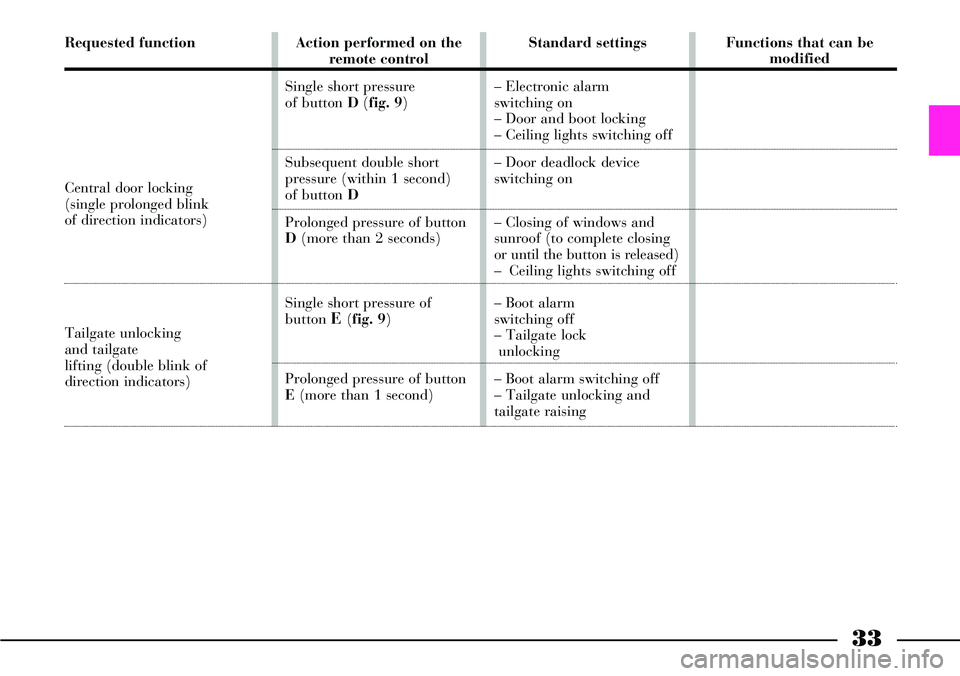
33
Requested function
Central door locking
(single prolonged blink
of direction indicators)
Tailgate unlocking and tailgate
lifting (double blink of
direction indicators)
Action performed on the
remote control
Single short pressure
of button D (fig. 9)
Subsequent double short
pressure (within 1 second)
of button D
Prolonged pressure of button
D(more than 2 seconds)
Single short pressure of
button
E (fig. 9)
Prolonged pressure of button
E(more than 1 second)Standard settings
– Electronic alarm
switching on
– Door and boot locking
– Ceiling lights switching off
– Door deadlock device
switching on
– Closing of windows and
sunroof (to complete closing
or until the button is released)
– Ceiling lights switching off
– Boot alarm
switching off
– Tailgate lock
unlocking
– Boot alarm switching off
– Tailgate unlocking and
tailgate raisingFunctions that can be
modified
Page 36 of 386
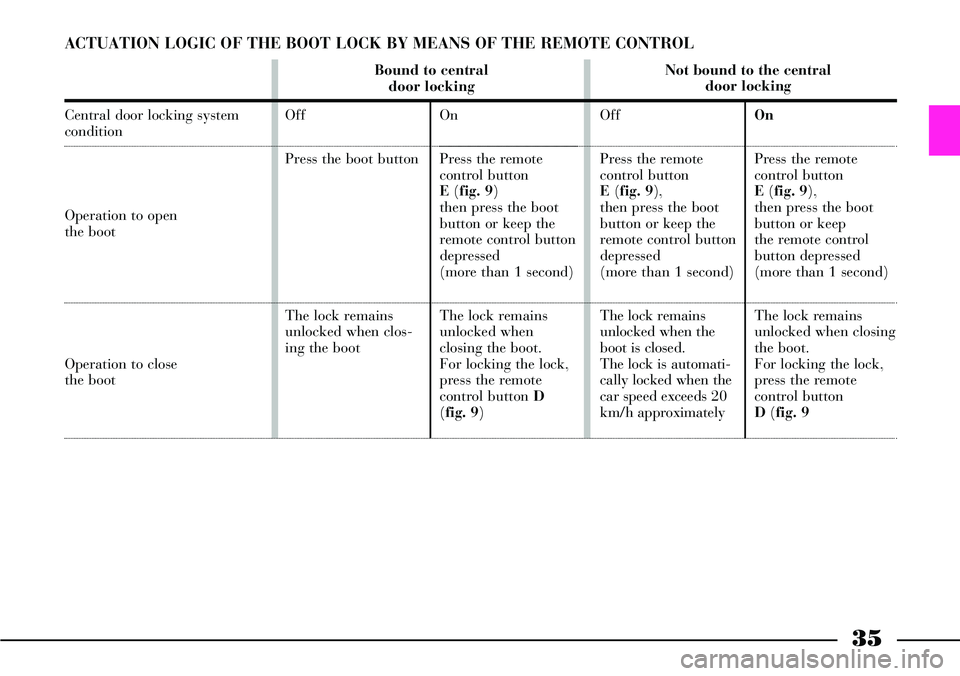
35
ACTUATION LOGIC OF THE BOOT LOCK BY MEANS OF THE REMOTE CONTROL
Central door locking system condition
Operation to open
the boot
Operation to close
the boot
Bound to central
door locking
Off
Press the boot button
The lock remains
unlocked when clos-
ing the bootOn
Press the remote
control button
E(fig. 9)
then press the boot
button or keep the
remote control button
depressed
(more than 1 second)
The lock remains
unlocked when
closing the boot.
For locking the lock,
press the remote
control button D
(fig. 9)Not bound to the central
door locking
Off
Press the remote
control button
E(fig. 9),
then press the boot
button or keep the
remote control button
depressed
(more than 1 second)
The lock remains
unlocked when the
boot is closed.
The lock is automati-
cally locked when the
car speed exceeds 20
km/h approximatelyOn
Press the remote
control button
E(fig. 9),
then press the boot
button or keep
the remote control
button depressed
(more than 1 second)
The lock remains
unlocked when closing
the boot.
For locking the lock,
press the remote
control button
D(fig. 9
Page 38 of 386
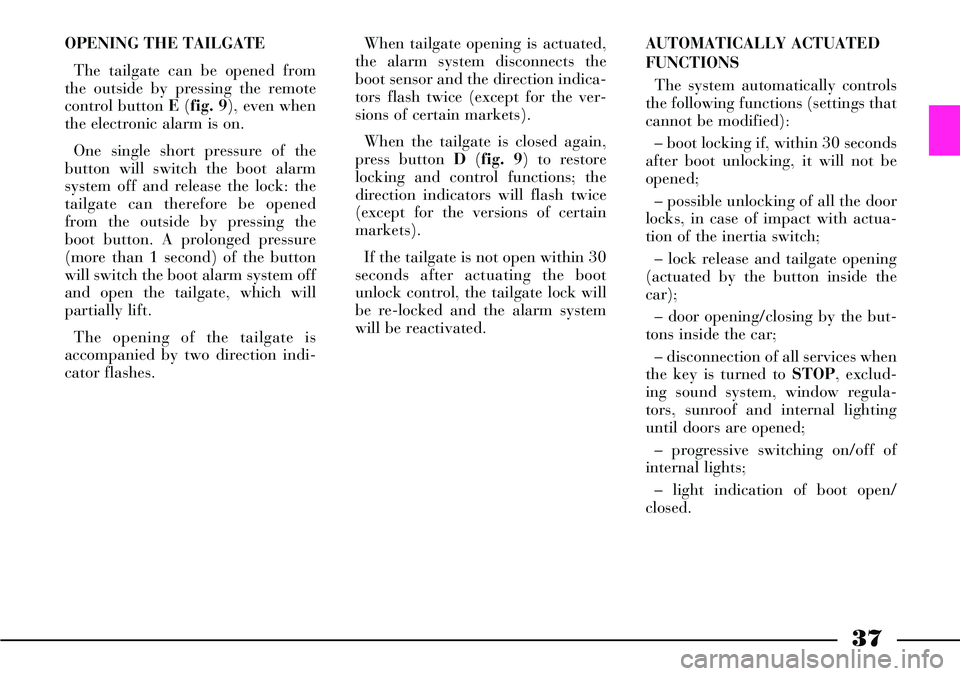
37
OPENING THE TAILGATE
The tailgate can be opened from
the outside by pressing the remote
control button E (fig. 9), even when
the electronic alarm is on.
One single short pressure of the
button will switch the boot alarm
system off and release the lock: the
tailgate can therefore be opened
from the outside by pressing the
boot button. A prolonged pressure
(more than 1 second) of the button
will switch the boot alarm system off
and open the tailgate, which will
partially lift.
The opening of the tailgate is
accompanied by two direction indi-
cator flashes.When tailgate opening is actuated,
the alarm system disconnects the
boot sensor and the direction indica-
tors flash twice (except for the ver-
sions of certain markets).
When the tailgate is closed again,
press button D(fig. 9) to restore
locking and control functions; the
direction indicators will flash twice
(except for the versions of certain
markets).
If the tailgate is not open within 30
seconds after actuating the boot
unlock control, the tailgate lock will
be re-locked and the alarm system
will be reactivated.AUTOMATICALLY ACTUATED
FUNCTIONS
The system automatically controls
the following functions (settings that
cannot be modified):
– boot locking if, within 30 seconds
after boot unlocking, it will not be
opened;
– possible unlocking of all the door
locks, in case of impact with actua-
tion of the inertia switch;
– lock release and tailgate opening
(actuated by the button inside the
car);
– door opening/closing by the but-
tons inside the car;
– disconnection of all services when
the key is turned to STOP, exclud-
ing sound system, window regula-
tors, sunroof and internal lighting
until doors are opened;
– progressive switching on/off of
internal lights;
– light indication of boot open/
closed.
Page 39 of 386
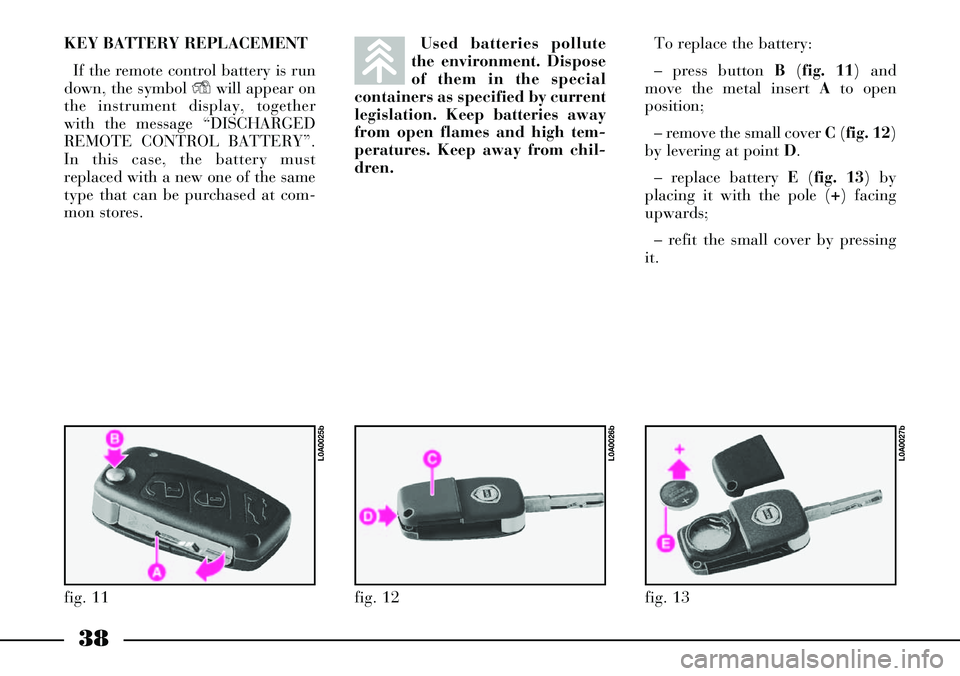
38
KEY BATTERY REPLACEMENT
If the remote control battery is run
down, the symbol Ywill appear on
the instrument display, together
with the message “DISCHARGED
REMOTE CONTROL BATTERY”.
In this case, the battery must
replaced with a new one of the same
type that can be purchased at com-
mon stores.Used batteries pollute
the environment. Dispose
of them in the special
containers as specified by current
legislation. Keep batteries away
from open flames and high tem-
peratures. Keep away from chil-
dren.To replace the battery:
– press button B (fig. 11) and
move the metal insert Ato open
position;
– remove the small cover C(fig. 12)
by levering at point D.
– replace battery E(fig. 13) by
placing it with the pole (+) facing
upwards;
– refit the small cover by pressing
it.
fig. 11
L0A0025b
fig. 12
L0A0026b
fig. 13
L0A0027b
Page 40 of 386

39
REQUEST FOR ADDITIONAL
KEYS WITH REMOTE
CONTROL
The receiver will acknowledge up
to eight keys with remote control. If
you ever need a new key with remote
control, go directly to a Lancia
Dealership, taking with you the
CODE card, personal identification
and the car ownership papers.ELECTRONIC
ALARM
The system consists of:
– radio-frequency transmitter
(built into the ignition key);
– radio-frequency receiver;
– electronic control unit with built-
in siren (the siren can be deactivat-
ed);
– volumetric sensors (which can be
deactivated);
– anti-lifting sensor (which can be
deactivated).
The electronic alarm is controlled
by the receiver and is switched
on/off by means of the remote con-
trol built into the key, which sends
the secret and variable code. The electronic alarm monitors:
– the illicit opening of doors, bon-
net and boot (perimetral protec-
tion);
– ignition switch operation;
– cutting of battery cables;
– moving bodies inside the passen-
ger compartment (volumetric pro-
tection)
– any abnormal raising/sloping of
the car.
IMPORTANTThe engine immo-
bilising system is governed by the
Lancia CODE system and is auto-
matically activated when the igni-
tion key is removed.
fig. 14
L0A0097b
Page 41 of 386
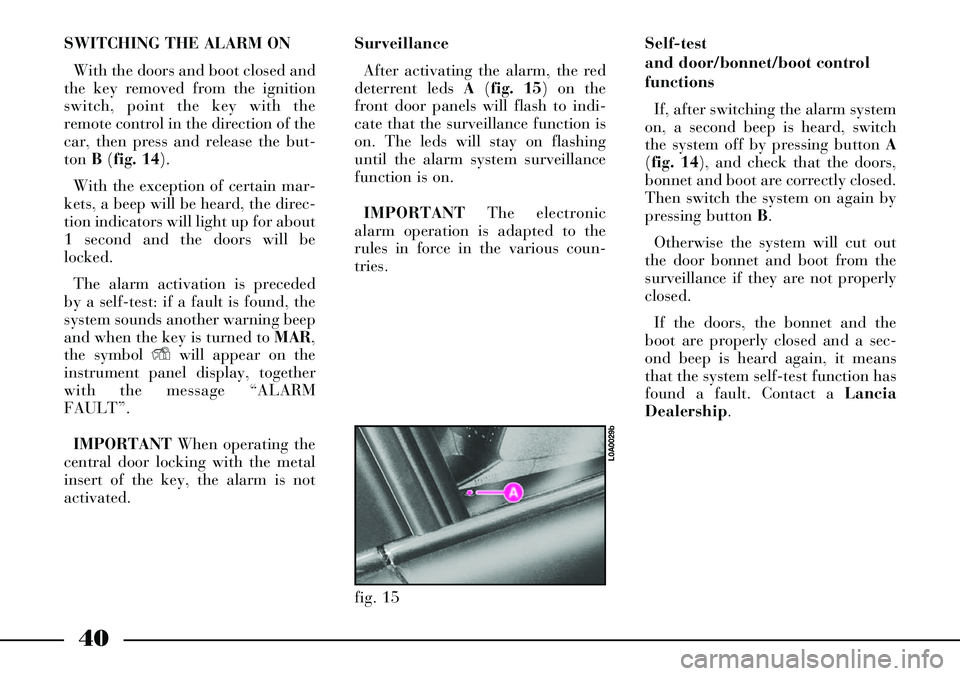
40
SWITCHING THE ALARM ON
With the doors and boot closed and
the key removed from the ignition
switch, point the key with the
remote control in the direction of the
car, then press and release the but-
ton B(fig. 14).
With the exception of certain mar-
kets, a beep will be heard, the direc-
tion indicators will light up for about
1 second and the doors will be
locked.
The alarm activation is preceded
by a self-test: if a fault is found, the
system sounds another warning beep
and when the key is turned to MAR,
the symbol Ywill appear on the
instrument panel display, together
with the message “ALARM
FAULT”.
IMPORTANTWhen operating the
central door locking with the metal
insert of the key, the alarm is not
activated.Surveillance
After activating the alarm, the red
deterrent leds A(fig. 15) on the
front door panels will flash to indi-
cate that the surveillance function is
on. The leds will stay on flashing
until the alarm system surveillance
function is on.
IMPORTANTThe electronic
alarm operation is adapted to the
rules in force in the various coun-
tries.Self-test
and door/bonnet/boot control
functions
If, after switching the alarm system
on, a second beep is heard, switch
the system off by pressing button A
(fig. 14), and check that the doors,
bonnet and boot are correctly closed.
Then switch the system on again by
pressing button B.
Otherwise the system will cut out
the door bonnet and boot from the
surveillance if they are not properly
closed.
If the doors, the bonnet and the
boot are properly closed and a sec-
ond beep is heard again, it means
that the system self-test function has
found a fault. Contact a Lancia
Dealership.
fig. 15
L0A0029b
Page 44 of 386
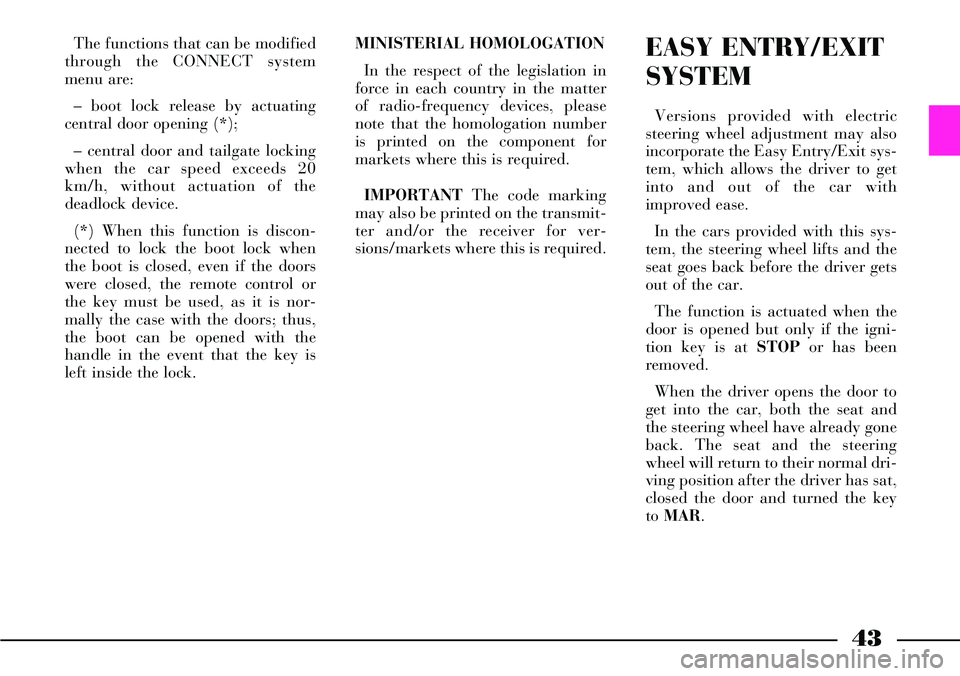
43
The functions that can be modified
through the CONNECT system
menu are:
– boot lock release by actuating
central door opening (*);
– central door and tailgate locking
when the car speed exceeds 20
km/h, without actuation of the
deadlock device.
(*) When this function is discon-
nected to lock the boot lock when
the boot is closed, even if the doors
were closed, the remote control or
the key must be used, as it is nor-
mally the case with the doors; thus,
the boot can be opened with the
handle in the event that the key is
left inside the lock.MINISTERIAL HOMOLOGATION
In the respect of the legislation in
force in each country in the matter
of radio-frequency devices, please
note that the homologation number
is printed on the component for
markets where this is required.
IMPORTANTThe code marking
may also be printed on the transmit-
ter and/or the receiver for ver-
sions/markets where this is required.EASY ENTRY/EXIT
SYSTEM
Versions provided with electric
steering wheel adjustment may also
incorporate the Easy Entry/Exit sys-
tem, which allows the driver to get
into and out of the car with
improved ease.
In the cars provided with this sys-
tem, the steering wheel lifts and the
seat goes back before the driver gets
out of the car.
The function is actuated when the
door is opened but only if the igni-
tion key is at STOPor has been
removed.
When the driver opens the door to
get into the car, both the seat and
the steering wheel have already gone
back. The seat and the steering
wheel will return to their normal dri-
ving position after the driver has sat,
closed the door and turned the key
to MAR.
Page 45 of 386
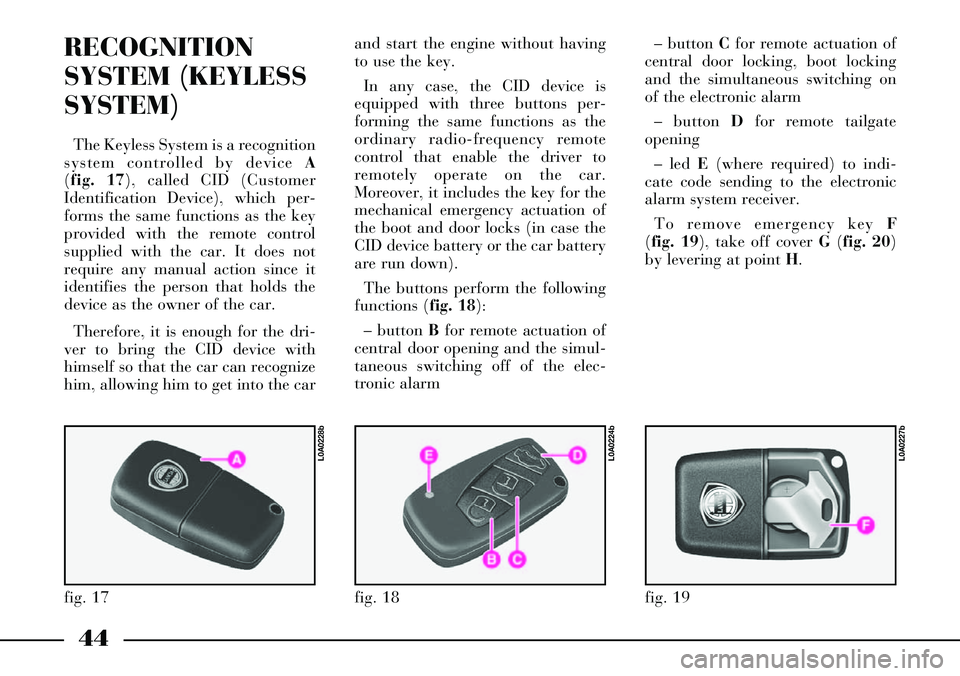
44
RECOGNITION
SYSTEM (KEYLESS
SYSTEM)
The Keyless System is a recognition
system controlled by device A
(fig. 17), called CID (Customer
Identification Device), which per-
forms the same functions as the key
provided with the remote control
supplied with the car. It does not
require any manual action since it
identifies the person that holds the
device as the owner of the car.
Therefore, it is enough for the dri-
ver to bring the CID device with
himself so that the car can recognize
him, allowing him to get into the carand start the engine without having
to use the key.
In any case, the CID device is
equipped with three buttons per-
forming the same functions as the
ordinary radio-frequency remote
control that enable the driver to
remotely operate on the car.
Moreover, it includes the key for the
mechanical emergency actuation of
the boot and door locks (in case the
CID device battery or the car battery
are run down).
The buttons perform the following
functions (fig. 18):
– button Bfor remote actuation of
central door opening and the simul-
taneous switching off of the elec-
tronic alarm– button Cfor remote actuation of
central door locking, boot locking
and the simultaneous switching on
of the electronic alarm
– button Dfor remote tailgate
opening
– led E(where required) to indi-
cate code sending to the electronic
alarm system receiver.
To remove emergency keyF
(fig. 19), take off cover G(fig. 20)
by levering at point H.
fig. 17
L0A0228b
fig. 18
L0A0224b
fig. 19
L0A0227b
Page 49 of 386
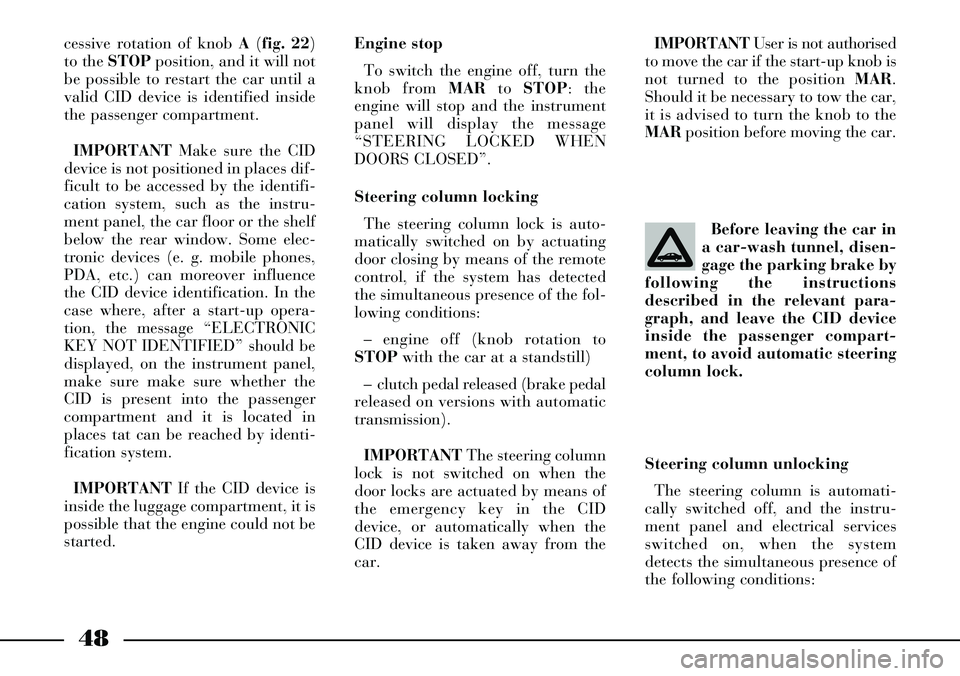
48
Before leaving the car in
a car-wash tunnel, disen-
gage the parking brake by
following the instructions
described in the relevant para-
graph, and leave the CID device
inside the passenger compart-
ment, to avoid automatic steering
column lock.IMPORTANTUser is not authorised
to move the car if the start-up knob is
not turned to the position MAR.
Should it be necessary to tow the car,
it is advised to turn the knob to the
MARposition before moving the car.
Steering column unlocking
The steering column is automati-
cally switched off, and the instru-
ment panel and electrical services
switched on, when the system
detects the simultaneous presence of
the following conditions:
cessive rotation of knob A(fig. 22)
to the STOPposition, and it will not
be possible to restart the car until a
valid CID device is identified inside
the passenger compartment.
IMPORTANTMake sure the CID
device is not positioned in places dif-
ficult to be accessed by the identifi-
cation system, such as the instru-
ment panel, the car floor or the shelf
below the rear window. Some elec-
tronic devices (e. g. mobile phones,
PDA, etc.) can moreover influence
the CID device identification. In the
case where, after a start-up opera-
tion, the message “ELECTRONIC
KEY NOT IDENTIFIED” should be
displayed, on the instrument panel,
make sure make sure whether the
CID is present into the passenger
compartment and it is located in
places tat can be reached by identi-
fication system.
IMPORTANTIf the CID device is
inside the luggage compartment, it is
possible that the engine could not be
started.Engine stop
To switch the engine off, turn the
knob from MARto STOP: the
engine will stop and the instrument
panel will display the message
“STEERING LOCKED WHEN
DOORS CLOSED”.
Steering column locking
The steering column lock is auto-
matically switched on by actuating
door closing by means of the remote
control, if the system has detected
the simultaneous presence of the fol-
lowing conditions:
– engine off (knob rotation to
STOPwith the car at a standstill)
– clutch pedal released (brake pedal
released on versions with automatic
transmission).
IMPORTANTThe steering column
lock is not switched on when the
door locks are actuated by means of
the emergency key in the CID
device, or automatically when the
CID device is taken away from the
car.
Page 52 of 386
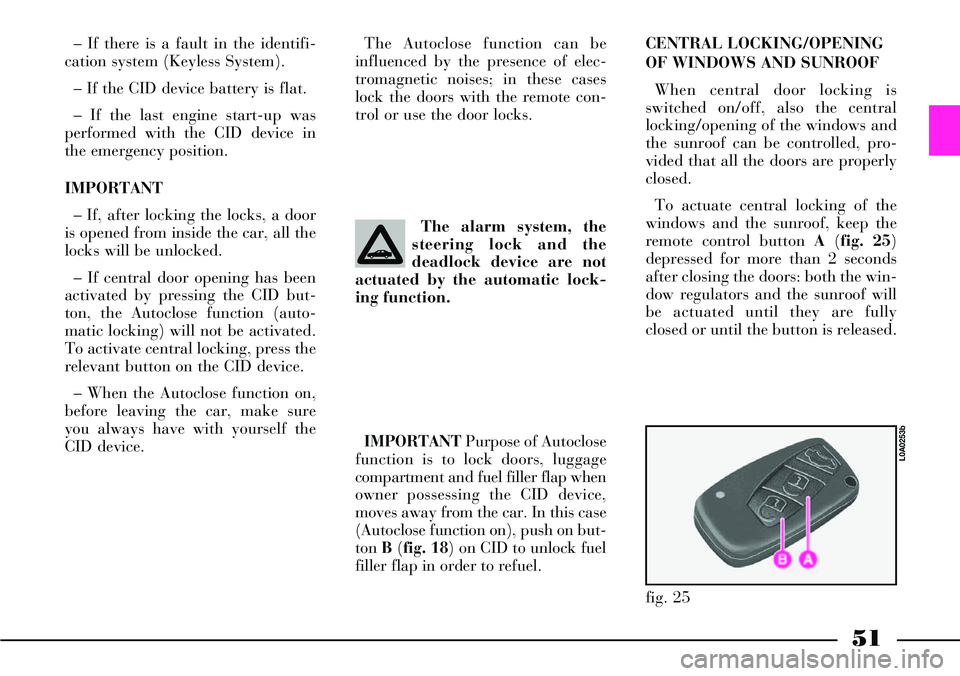
51
The alarm system, the
steering lock and the
deadlock device are not
actuated by the automatic lock-
ing function.
IMPORTANTPurpose of Autoclose
function is to lock doors, luggage
compartment and fuel filler flap when
owner possessing the CID device,
moves away from the car. In this case
(Autoclose function on), push on but-
ton B(fig. 18) on CID to unlock fuel
filler flap in order to refuel. – If there is a fault in the identifi-
cation system (Keyless System).
– If the CID device battery is flat.
– If the last engine start-up was
performed with the CID device in
the emergency position.
IMPORTANT
– If, after locking the locks, a door
is opened from inside the car, all the
locks will be unlocked.
– If central door opening has been
activated by pressing the CID but-
ton, the Autoclose function (auto-
matic locking) will not be activated.
To activate central locking, press the
relevant button on the CID device.
– When the Autoclose function on,
before leaving the car, make sure
you always have with yourself the
CID device.The Autoclose function can be
influenced by the presence of elec-
tromagnetic noises; in these cases
lock the doors with the remote con-
trol or use the door locks.
CENTRAL LOCKING/OPENING
OF WINDOWS AND SUNROOF
When central door locking is
switched on/off, also the central
locking/opening of the windows and
the sunroof can be controlled, pro-
vided that all the doors are properly
closed.
To actuate central locking of the
windows and the sunroof, keep the
remote control button A(fig. 25)
depressed for more than 2 seconds
after closing the doors: both the win-
dow regulators and the sunroof will
be actuated until they are fully
closed or until the button is released.
fig. 25
L0A0253b